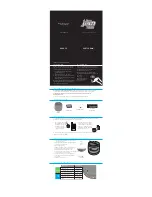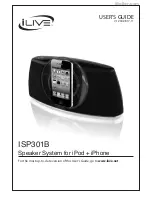
Level:
O (indicated by the dot)
Crossover:
150Hz
EQ:
OdB
Phase:
180° for any MAINstage, or O° for other speakers
• Level matching –
Use the SUBstage level control to provide a smooth transition to the main
speaker system.
• Crossover (xover) frequency matching
– This sets the upper frequency limits of your
SUBstage and is used to help provide a smooth transition between your main speakers (or
MAINstage) and your SUBstage.
• EQ –
pr3dB boost for added action impact. It may be preferred when the SUBstage
is not mounted in a corner or against one or more walls, or if you are a heavy movie-watcher.
• Variable Phase –
Since your main speakers (or MAINstage) and subwoofer are separate
units, they are also probably located at different distances from your ear. Depending on the
locations, it is possible that this difference will cause the soundwave of the subwoofer to arrive
at your ear a split-second earlier (or later) than the lows from the main speakers and therefore
“out of phase” enough to cancel some mid-bass frequencies.
The SUBstage100 offers a continuously variable phase adjustment to correct this problem.
How to use it: first, enlist a friend. Then, while listening to something familiar with steady mid-
bass signal (i.e., drums or electric bass), you sit in the listening location and have your friend
adjust the control until you hear the most bass (the change may be subtle).
For more info on phase adjustment, visit the FAQ section of our website
.
6
7
Power
Connect the supplied right-angle power cord
into the back of the SUBstage and connect
to the wall, 100–265 Vac
Switch Master Power to On position.
ON=
|
, OFF=
O
.
The SUBstage automatically switches from
standby to ON mode when it senses an audio
signal and switches back to standby mode
if no signal is present.
Bi-directional
connectors
for signal input and
output daisy-chaining
Available
room/movie
EQ boost switch
Output level adjustment
(Dot indicates factory
default “O” setting)
Power On LED indicator
Continuously variable
phase adjustment
(180° is factory default setting)
Crossover adjusts
high-frequency cut-off
(150Hz is factory
default setting)
3. Controls
Control Settings
Start with these pre-set factory settings then experiment for best sound in your system.
4. Using Multiple SUBstages
Hooking up multiple SUBstages is very simple – just a matter of “daisy-chaining” – using
an RCA or Mini interconnect between each of them. Adding a second (or more) subwoofers
will increase the sound press level (SPL) potential of your system. Additionally, the typical
and problematic bass dips and peaks caused by room acoustics can often be smoothed by
strategic placement of multiple subwoofers. Adding a second SUBstage will provide a dramatic
improvement in most installations.
The RCA and the Mini jacks on the SUBstage accept both input and output. You can connect
two SUBstages from RCA-to-RCA, Mini-to-Mini or RCA-to-Mini. Whenever using an RCA
interconnect for daisy-chaining, you can use either the red or white plug.
Sub output source,
such as MAINstage
SUBstage #1
SUBstage #2
SUBstage #3
SUBstage #4
Sub output source,
such as MAINstage,
connect using Y-adapter
SUBstage #1
SUBstage #2
SUBstage #3
SUBstage #4
Its unique flexibility mean the options for placing and hiding multiple SUBstages are virtually
endless. Options below show: A. left & right front pair hidden behind the TV, B. discrete front
and back pair, C. four on the side walls, and D. four in the corners. The SUBstage can easily be
placed on the floor or mounted on the wall, and hidden behind a plant or end table or chair.
We call this a “bass-board” – multiple SUBstages stashed behind
a sofa against the wall. While nicely hidden from view, you’ll hear
and feel lower frequencies with awesome power.
Some people prefer to display their SUBstage in plain view, like a piece of sculpture. The
optional pedestal, cosmetic front and rear grilles, and side panels will truly enhance its natural
aesthetics. Even with some hidden, you may want to show off one or more.
























